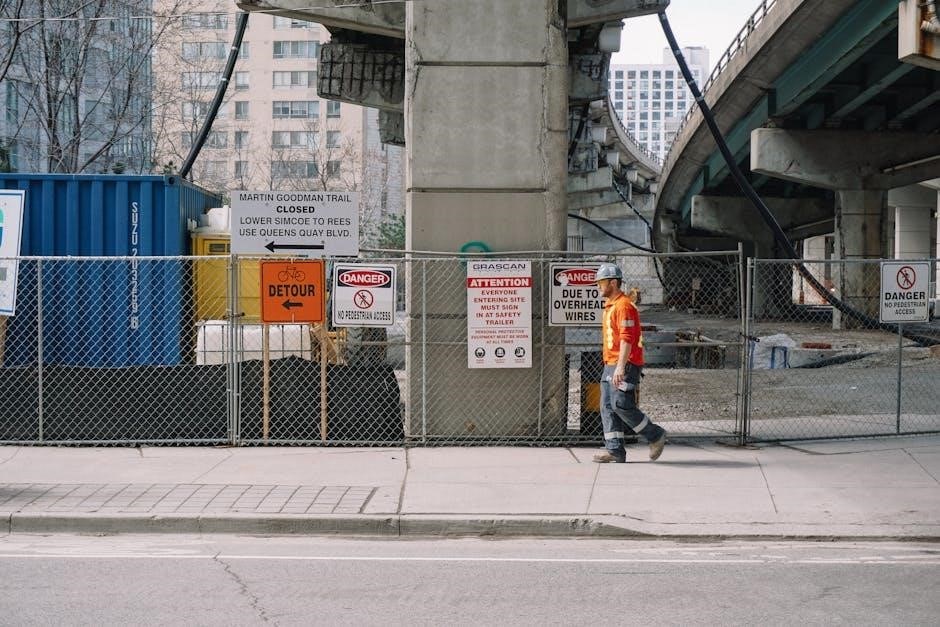new construction walk through checklist pdf
A new construction walk-through checklist is a detailed guide ensuring all aspects of a newly built home are inspected thoroughly before closing. It helps identify issues‚ verify quality‚ and ensure everything functions as intended. Available in PDF formats‚ these checklists provide a structured approach to evaluating exterior and interior elements‚ systems‚ and finishes‚ ensuring a smooth transition to homeownership.
What is a New Construction Walk-Through Checklist?
A new construction walk-through checklist is a comprehensive‚ organized document designed to guide homeowners through a detailed inspection of their newly built property. It typically covers both exterior and interior elements‚ including structural components‚ systems‚ and finishes. Available in downloadable PDF formats‚ these checklists ensure that all aspects of the home are evaluated before closing. They help identify potential issues‚ verify the quality of workmanship‚ and confirm that all features function as intended. Customizable to specific needs‚ the checklist ensures a thorough review of plumbing‚ electrical systems‚ fixtures‚ and structural integrity‚ providing a clear record of the home’s condition for future reference.
Purpose of a Walk-Through Checklist in New Construction
The purpose of a walk-through checklist in new construction is to ensure a smooth transition to homeownership by identifying and addressing any issues before closing. It serves as a systematic tool to verify the quality of workmanship‚ functionality of systems‚ and completeness of finishes. The checklist covers exterior and interior elements‚ including structural components‚ plumbing‚ electrical systems‚ and fixtures. It allows homeowners and builders to collaborate on resolving defects‚ ensuring all aspects of the home meet expectations. By documenting every detail‚ the checklist provides a clear record of the property’s condition‚ fostering transparency and accountability. This ensures a worry-free ownership experience from day one.

Why a Walk-Through Checklist is Important
A walk-through checklist ensures structural integrity‚ identifies issues‚ and resolves defects‚ providing peace of mind and fostering transparency and accountability between homeowners and builders.
Ensuring Structural Integrity and Safety
A thorough walk-through ensures the home’s structural integrity by inspecting foundations‚ walls‚ and roofs for cracks or damage. It verifies that all systems‚ including electrical and plumbing‚ function safely and meet building codes. This step is crucial for identifying potential hazards‚ such as faulty wiring or unstable structures‚ which could pose risks to occupants. By addressing these issues early‚ homeowners can avoid costly repairs and ensure their new home is secure and safe for years to come. A detailed checklist helps prioritize inspections‚ guaranteeing no critical aspects are overlooked‚ and fostering trust between homeowners and builders.
Identifying Cosmetic and Functional Issues
A new construction walk-through checklist helps identify cosmetic and functional issues that may have been overlooked during construction. Cosmetic issues include cracks in walls‚ ceilings‚ or floors‚ uneven surfaces‚ and paint defects. Functional issues involve verifying the proper operation of doors‚ windows‚ and systems like plumbing and electrical. This step ensures that all fixtures‚ appliances‚ and finishes meet the expected quality standards. By addressing these issues early‚ homeowners can request repairs or adjustments before finalizing the purchase. A detailed checklist ensures no minor or major flaws are missed‚ helping to maintain the home’s value and functionality for years to come.
Providing Peace of Mind for Homeowners
A new construction walk-through checklist offers homeowners peace of mind by ensuring their newly built home is thoroughly inspected and free from defects. This process allows buyers to verify that all systems‚ fixtures‚ and finishes meet quality standards before closing. By identifying and addressing issues early‚ homeowners can avoid potential headaches and financial burdens down the line. A comprehensive checklist serves as a safeguard‚ providing reassurance that the property is safe‚ functional‚ and ready for occupancy. This structured approach helps homeowners feel confident in their investment‚ knowing every detail has been carefully reviewed and approved.

How to Use a New Construction Walk-Through Checklist
Using a new construction walk-through checklist involves selecting the right template‚ tailoring it to your needs‚ and systematically inspecting each area to ensure functionality and document defects.
Step 1: Choose the Right Checklist for Your Inspection Phase
Selecting the appropriate checklist tailored to your inspection phase is crucial. For new construction‚ checklists vary based on the stage of completion‚ such as pre-drywall or final walk-through. Ensure the checklist aligns with your project’s specific needs‚ covering essential areas like exterior‚ interior‚ plumbing‚ and electrical systems. Downloadable PDF templates are widely available‚ offering structured formats to guide your inspection. Choose checklists that are comprehensive yet customizable‚ allowing you to focus on critical aspects of your new home. This step ensures you have a clear‚ organized tool to evaluate every detail effectively during your walkthrough.
Step 2: Tailor the Checklist to Your Specific Needs
Customizing your checklist ensures it addresses your home’s unique features and requirements. Start with a downloadable PDF template and modify it to include specific areas of concern‚ such as plumbing fixtures or electrical systems. Add notes or photos to document findings. For example‚ if your home has custom woodwork‚ include detailed checks for trim and molding. Tailor the checklist to your builder’s specifications or your personal preferences. This step ensures no detail is overlooked‚ providing a personalized inspection tool. A well-tailored checklist helps streamline the walk-through process‚ making it more efficient and relevant to your new home’s condition and features.
Step 3: Conduct a Thorough Walk-Through Inspection
Begin your inspection by systematically evaluating each area of the home‚ starting with the exterior. Check the foundation‚ walls‚ and roof for any cracks or damage. Inside‚ inspect walls‚ ceilings‚ and floors for uneven surfaces or defects. Test all doors and windows to ensure they open and close properly. Examine plumbing fixtures‚ electrical outlets‚ and appliances for functionality. Pay attention to details like trim‚ molding‚ and paint quality. Use a checklist to track findings and take photos or videos for documentation; Be methodical and thorough to identify any issues early‚ ensuring the home meets your standards and is ready for occupancy.

Key Areas to Inspect During the Walk-Through
Inspect exterior (foundation‚ walls‚ roof)‚ interior (walls‚ ceilings‚ floors)‚ doors‚ windows‚ plumbing‚ electrical systems‚ kitchen‚ bathrooms‚ and attic insulation for quality and functionality.
Exterior Inspection: Foundation‚ Walls‚ and Roof
Exterior inspection involves checking the foundation for cracks or unevenness‚ ensuring walls are straight and secure‚ and verifying the roof for leaks‚ damaged shingles‚ or missing tiles. Inspect siding for damage‚ gaps‚ or improper installation. Check gutters and downspouts for proper alignment and functionality. Ensure all exterior doors and windows are sealed correctly and function smoothly. Look for any signs of water damage‚ staining‚ or structural issues. Verify that all exterior systems‚ such as vents or electrical outlets‚ are properly installed and functioning. Document any defects or areas needing repair to address them before finalizing the walkthrough.
Interior Inspection: Walls‚ Ceilings‚ and Floors
Interior inspection focuses on evaluating walls‚ ceilings‚ and floors for quality and defects. Check walls for cracks‚ uneven surfaces‚ or paint imperfections. Ceilings should be smooth‚ free of cracks‚ and properly finished. Floors must be level‚ securely installed‚ and free of gaps or damage. Verify that all surfaces align correctly and meet standards. Ensure flooring materials‚ such as hardwood‚ tile‚ or carpet‚ are installed correctly and without defects. Look for any signs of water damage‚ staining‚ or unevenness. Document any issues‚ ensuring repairs are addressed before finalizing the walkthrough to guarantee a flawless living space for the homeowner.
Doors and Windows: Functionality and Condition
Inspecting doors and windows ensures proper functionality and condition. Check that all doors open and close smoothly‚ align properly‚ and seal tightly when closed. Verify that door handles‚ locks‚ and hinges are securely installed and functioning correctly. For windows‚ ensure they open‚ close‚ and lock without difficulty‚ and that all panes are free of cracks or damage. Look for proper caulking and weather-tight seals around frames. Test window screens for damage or tears. Check for any gaps or misalignment that could affect energy efficiency or security. Document any issues‚ such as scratches‚ dents‚ or improper installation‚ to ensure repairs are made before finalizing the walkthrough.
Plumbing and Electrical Systems: Functionality and Safety
Inspect plumbing by running faucets to check water pressure‚ drainage‚ and leaks under sinks‚ around toilets‚ and near appliances. Ensure all fixtures function properly and water heaters operate efficiently. For electrical systems‚ test switches‚ outlets‚ and lighting to confirm they work correctly. Check circuit breakers and ensure GFCI outlets trip when tested. Verify that all installations meet safety standards and are free from visible damage. Document any issues like flickering lights‚ faulty outlets‚ or water leaks. Addressing these ensures a safe and functional living environment‚ preventing potential hazards and costly repairs down the line. Proper documentation helps prioritize and resolve these issues promptly.
Kitchen and Bathrooms: Fixtures and Appliances
In the kitchen‚ inspect cabinets‚ countertops‚ and appliances for proper installation and damage. Test major appliances like ovens‚ dishwashers‚ and microwaves to ensure they function correctly; Check for leaks under sinks and around dishwashers. In bathrooms‚ examine sinks‚ toilets‚ showers‚ and bathtubs for cracks or damage. Verify that all fixtures‚ such as faucets and showerheads‚ are securely installed and leak-free. Test water temperature and pressure in showers and sinks; Ensure mirrors and lighting are properly installed. Document any issues‚ such as uneven countertops or malfunctioning appliances‚ and take photos for reference; Addressing these ensures the kitchen and bathrooms are safe‚ functional‚ and ready for use‚ providing peace of mind for homeowners.
Attic and Insulation: Quality and Adequacy
Inspect the attic for proper insulation quality and coverage‚ ensuring no gaps or damage. Verify that insulation meets local building codes for energy efficiency. Check for signs of leaks‚ water damage‚ or mold. Ensure the attic hatch or door is securely installed and well-sealed. Look for any sagging or uneven areas in the insulation. Document any issues with photos‚ noting areas needing repair. Proper insulation ensures energy efficiency and prevents future issues. Addressing these elements guarantees the attic is safe‚ functional‚ and meets regulatory standards‚ providing a solid foundation for the home’s overall comfort and efficiency.

Common Issues to Look for During the Walk-Through
Common issues include cracks in walls‚ damaged wood trim‚ plumbing leaks‚ and malfunctioning appliances‚ which should be documented and addressed promptly for a smooth transition.
Cracks in Walls‚ Ceilings‚ and Floors
Cracks in walls‚ ceilings‚ and floors are common issues to look for during a walk-through. They can indicate structural settling or potential foundation problems. Inspect for new cracks‚ movement‚ or enlargement of existing ones. Check both interior and exterior surfaces‚ paying attention to areas around windows‚ doors‚ and joints. Use a flashlight to spot hairline cracks and measure their width. Document any findings‚ as significant cracks may require further evaluation by professionals. Addressing these issues early ensures structural integrity and prevents costly repairs later. Include photos and measurements in your checklist for clarity and follow-up with the builder or contractors.
Damage to Wood Elements: Trim‚ Molding‚ and Joints

Damaged wood elements‚ such as trim‚ molding‚ and joints‚ are common issues in new construction. Inspect for gaps‚ unevenness‚ or scratches in woodwork. Check crown molding‚ baseboards‚ and door frames for proper alignment and finish. Look for loose joints or separations in wood panels. Test wood surfaces for scratches or dents. Ensure all wood elements are securely fastened and free from damage. Document any defects with photos and notes. Addressing these issues ensures a polished finish and prevents future maintenance. Use your checklist to prioritize repairs and discuss them with the builder for timely resolution before closing.
Leaks in Plumbing and Roofing
Leaks in plumbing and roofing are critical issues to identify during a new construction walk-through. Check for water spots‚ stains‚ or warping on ceilings and walls. Inspect pipes under sinks‚ around fixtures‚ and in the garage for signs of moisture. Run all faucets to ensure proper water flow and check for drips or leaks; Examine the roof for missing or damaged shingles‚ curled edges‚ or gaps in flashing. Look for stains or water damage around vents‚ chimneys‚ and skylights. Document any leaks or potential issues with photos and notes. Addressing these promptly prevents costly repairs and ensures a secure‚ water-tight home.
Malfunctioning Appliances and Fixtures
Malfunctioning appliances and fixtures are common issues to identify during a new construction walk-through. Test all installed appliances‚ such as ovens‚ dishwashers‚ and refrigerators‚ to ensure they function correctly. Check lighting fixtures‚ ceiling fans‚ and outlets for proper operation. Inspect plumbing fixtures like faucets‚ toilets‚ and showers for leaks or improper installation; Examine cabinets and drawers for smooth operation and alignment; Document any issues with photos or notes‚ including serial numbers and model details. Addressing these defects ensures all systems and features are in working order before finalizing the purchase‚ providing peace of mind for homeowners. Proper documentation helps resolve issues promptly.

How to Document Issues Found During the Walk-Through
Document issues by creating a detailed list‚ using photos and videos for visual evidence‚ and prioritizing repairs. This ensures clarity and efficiency in addressing defects with the builder.
Creating a Detailed List of Defects
Creating a detailed list of defects during the walk-through ensures all issues are clearly documented and addressed. Start by systematically inspecting each area‚ noting specific problems like cracks in walls‚ uneven floors‚ or malfunctioning fixtures. Use the PDF checklist as a guide to ensure no detail is overlooked. For each defect‚ include its location‚ description‚ and severity level. This structured approach helps prioritize repairs and provides a clear reference for discussions with the builder. Examples of defects to document include damaged wood trim‚ leaks in plumbing‚ or improperly installed appliances. A comprehensive list ensures transparency and accountability‚ making it easier to resolve issues before closing.
Using Photos and Videos for Documentation
Photographs and videos are essential tools for documenting issues during a new construction walk-through. Capture clear‚ well-lit images of defects‚ such as cracks‚ damaged trim‚ or malfunctioning fixtures. Videos can provide a comprehensive view of larger areas or moving parts‚ like doors and windows. Include close-ups to highlight specific problems and ensure each photo is time-stamped or labeled with the location. Organize these visuals alongside your written checklist‚ referencing each image with a corresponding note. This visual documentation serves as indisputable evidence‚ helping to ensure repairs are made correctly and providing a permanent record for future reference. Proper organization enhances clarity and accountability for all parties involved.
Prioritizing Repairs and Negotiating with the Builder
After documenting all issues‚ prioritize repairs based on severity and impact. Separate critical defects‚ such as structural or safety hazards‚ from cosmetic issues like paint touch-ups. Use your checklist and visual evidence to negotiate with the builder effectively. Clearly communicate the list of defects‚ ensuring each item is addressed. Builders often prefer to resolve issues before closing to ensure customer satisfaction. Discuss timelines and responsibility for repairs‚ and confirm agreements in writing. This collaborative approach ensures that all problems are resolved efficiently‚ providing peace of mind for homeowners and maintaining a positive relationship with the builder.

Final Steps After the Walk-Through
After addressing all issues‚ review and finalize the checklist‚ ensuring repairs are completed. Once satisfied‚ sign off to proceed with closing‚ securing a smooth transition to homeownership.
Reviewing and Finalizing the Checklist
After conducting the walk-through‚ carefully review the checklist to ensure all identified issues have been documented and addressed. Verify that repairs are completed to your satisfaction and that no new defects have appeared. Cross-check each item‚ ensuring the home meets the agreed-upon standards. Take photos and notes for clarity‚ especially for any remaining concerns. Once everything is confirmed‚ finalize the checklist and obtain signatures from all parties involved. This step ensures accountability and serves as a record of the home’s condition at the time of closing. A thorough review is essential for a smooth transition to homeownership.
Addressing Any Remaining Issues
After identifying issues during the walk-through‚ prioritize repairs based on severity and urgency. Create a detailed list of defects‚ including photos and descriptions‚ to share with the builder. Ensure all cosmetic and functional problems‚ such as cracks‚ leaks‚ or malfunctioning appliances‚ are addressed. Schedule a follow-up inspection if necessary to verify repairs. Communicate clearly with the builder to resolve any disputes or unanswered concerns. Once all issues are satisfactorily resolved‚ confirm in writing to avoid future disputes. This ensures the home is move-in ready and meets your expectations‚ providing peace of mind as you proceed to closing.
Signing Off and Proceeding to Closing
Once all issues are resolved and verified‚ review and sign off on the final walkthrough checklist. This confirms the home meets agreed standards and is ready for occupancy. Ensure all repairs are documented and approved before proceeding. Finalize the checklist and submit it to the builder for their records. This step legally acknowledges the home’s condition and clears the way for closing. After signing‚ review and complete any remaining paperwork with your builder or legal representative. Receive all necessary documents‚ such as warranties and manuals‚ for appliances and systems. With everything finalized‚ you can confidently proceed to closing‚ marking the successful completion of your new home journey.

Additional Resources and Templates
Access comprehensive new construction walk-through checklist templates in PDF‚ Excel‚ Word‚ and Google Docs. Download free‚ customizable guides to ensure a thorough inspection and smooth closing process.

Downloadable PDF Templates for Walk-Through Checklists
Downloadable PDF templates for new construction walk-through checklists are widely available online‚ offering a structured and comprehensive approach to home inspections. These templates are customizable to suit specific needs‚ covering exterior and interior elements‚ plumbing‚ electrical systems‚ and more. Many websites provide free templates in PDF‚ Excel‚ Word‚ and Google Docs formats‚ allowing users to tailor the checklist to their project requirements. They include detailed sections for inspecting walls‚ ceilings‚ floors‚ doors‚ windows‚ and fixtures. These templates ensure a thorough evaluation‚ helping homeowners and builders identify issues before closing. They are easy to use and save time‚ ensuring a smooth transition to homeownership.
Free Excel‚ Word‚ and Google Doc Templates
Free Excel‚ Word‚ and Google Doc templates for new construction walk-through checklists are readily available online‚ offering flexibility and customization. These templates allow users to tailor the checklist to their specific needs‚ ensuring a detailed inspection of all home aspects. They include sections for exterior‚ interior‚ plumbing‚ electrical systems‚ and more‚ making it easy to track issues. With drag-and-drop functionality‚ users can add or remove items as needed. These templates are ideal for homeowners and builders‚ providing a structured approach to identify and document defects. They save time and ensure a thorough evaluation‚ making the transition to homeownership smooth and stress-free.
Guides and Tutorials for Customizing Your Checklist
Guides and tutorials are available to help users customize their new construction walk-through checklists effectively. These resources provide step-by-step instructions and video tutorials to ensure users can tailor their checklists to meet specific needs. They cover how to add or remove sections‚ prioritize items‚ and integrate photos and notes. Many guides also offer tips for maximizing the checklist’s effectiveness during inspections. Whether you prefer written instructions or visual aids‚ these tools empower homeowners and builders to create a comprehensive and personalized evaluation process‚ ensuring no detail is overlooked during the final walk-through.
A comprehensive new construction walk-through checklist ensures quality‚ safety‚ and peace of mind for homeowners. It streamlines the inspection process‚ helping buyers transition smoothly into their new home.
Importance of a Comprehensive Walk-Through Checklist
A comprehensive walk-through checklist is essential for ensuring the quality and safety of a newly constructed home; It helps identify issues early‚ allowing for timely repairs and ensuring all systems function as intended. By systematically evaluating every aspect of the property‚ from structural elements to finishes‚ homeowners can gain confidence in their investment. A detailed checklist also facilitates clear communication between buyers and builders‚ ensuring accountability and transparency. This process not only safeguards against potential problems but also provides peace of mind‚ knowing that the home meets high standards and is ready for occupancy.
Ensuring a Smooth Transition to Homeownership
A comprehensive walk-through checklist is crucial for a seamless transition to homeownership. It ensures that all aspects of the new construction are thoroughly inspected‚ identifying and addressing any issues before closing. This process verifies that the home meets quality standards‚ functions as intended‚ and is free from defects. By systematically evaluating every detail‚ homeowners can avoid post-closing surprises‚ such as hidden damages or malfunctions. A well-organized checklist also reduces stress‚ allowing buyers to focus on the excitement of moving into their new home. It ensures a flawless handover‚ giving homeowners confidence in their investment and a smooth start to their new life.